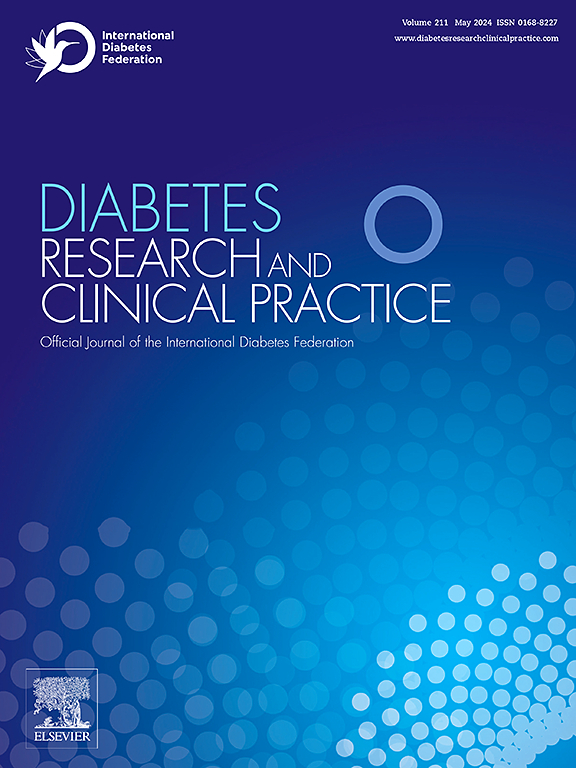Association of the estimated glucose disposal rate with and mortality risk in patients with atherosclerotic cardiovascular disease: A cohort study from the NHANES 1999–2018
IF 6.1
3区 医学
Q1 ENDOCRINOLOGY & METABOLISM
引用次数: 0
Abstract
Aim
To investigate the association between estimated glucose disposal rate (eGDR) and mortality risk among patients with atherosclerotic cardiovascular disease (ASCVD).
Methods
NHANES (1999–2018) data were analyzed using weighted Cox regression and restricted cubic splines (RCS) to assess the association between eGDR and mortality. Improvement in predictive performance was evaluated. Subgroup, mediation, and sensitivity analyses were conducted.
Results
Among 4,425 ASCVD patients (67.40 % ≥60 years, 44.66 % female), 1,815 deaths (35.62 %) and 751 CVD deaths (18.48 %) occurred during a median follow-up of 6.9 years. Compared to the highest quartile, the lowest eGDR quartile had HRs of 2.13 and 2.06 for CVD and all-cause mortality, respectively. RCS demonstrated linearity (P-nonlinear > 0.05). Addition of eGDR improved the predictive performance for both CVD and all-cause mortality (P < 0.001), whereas other insulin resistance indicators did not yield comparable improvements. Diabetes status modified its association with CVD mortality (P-interaction = 0.029). Neutrophil-to-lymphocyte ratio and estimated pulse wave velocity were key mediators.
Conclusions
Lower eGDR was associated with increased mortality risk in ASCVD, particularly among patients without diabetes. eGDR enhances mortality prediction and may serve as a prognostic marker in ASCVD.
动脉粥样硬化性心血管疾病患者估计葡萄糖处理率与死亡风险的关系:来自NHANES 1999-2018的队列研究
目的:探讨动脉粥样硬化性心血管疾病(ASCVD)患者估计葡萄糖处置率(eGDR)与死亡风险之间的关系。方法:采用加权Cox回归和限制性三次样条(RCS)分析NHANES(1999-2018)数据,评估eGDR与死亡率之间的关系。评估预测性能的改善。进行了亚组分析、中介分析和敏感性分析。结果:4425例ASCVD患者(67.40 %≥60 岁,44.66 %为女性)中,1815例死亡(35.62 %)和751例CVD死亡(18.48 %)发生在7.7 岁以上。与最高四分位数相比,最低eGDR四分位数的心血管疾病和全因死亡率的hr分别为2.13和2.06。RCS呈线性(p -非线性 > 0.05)。eGDR的加入提高了CVD和全因死亡率的预测性能(P < 0.001),而其他胰岛素抵抗指标没有产生可比的改善。糖尿病状况改变了其与CVD死亡率的关系(p相互作用 = 0.029)。中性粒细胞与淋巴细胞的比率和估计的脉冲波速度是关键的介质。结论:较低的eGDR与ASCVD死亡风险增加相关,特别是在无糖尿病患者中。eGDR提高了死亡率预测,支持其作为ASCVD预后标志物的作用。
本文章由计算机程序翻译,如有差异,请以英文原文为准。
求助全文
约1分钟内获得全文
求助全文
来源期刊

Diabetes research and clinical practice
医学-内分泌学与代谢
CiteScore
10.30
自引率
3.90%
发文量
862
审稿时长
32 days
期刊介绍:
Diabetes Research and Clinical Practice is an international journal for health-care providers and clinically oriented researchers that publishes high-quality original research articles and expert reviews in diabetes and related areas. The role of the journal is to provide a venue for dissemination of knowledge and discussion of topics related to diabetes clinical research and patient care. Topics of focus include translational science, genetics, immunology, nutrition, psychosocial research, epidemiology, prevention, socio-economic research, complications, new treatments, technologies and therapy.
 求助内容:
求助内容: 应助结果提醒方式:
应助结果提醒方式:


